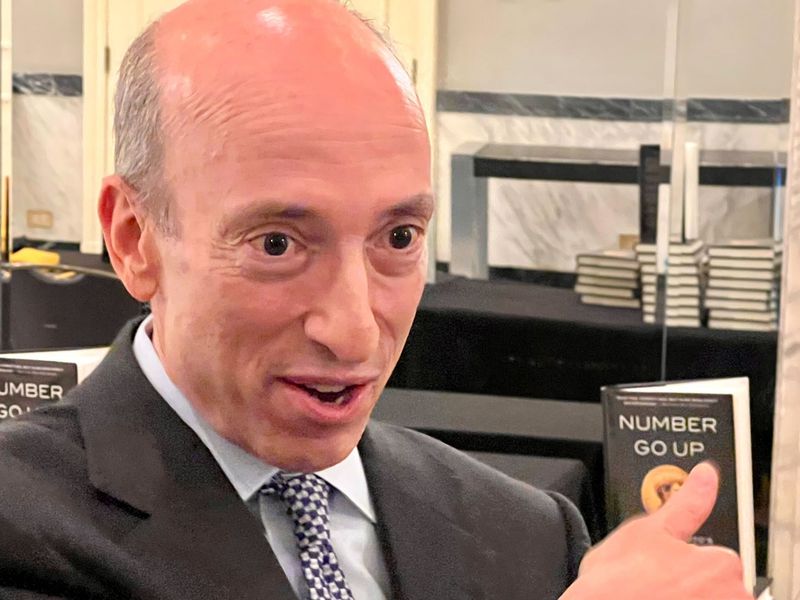Blockstream Developer Neigut Expects ‘Cambrian Explosion’ of Bitcoin Layer 2 Protocols
The Bitcoin ecosystem, derided in some crypto developer circles for its slow pace of technological advancement, is now on the verge of a layer 2 “Cambrian explosion.”
That’s according to Lisa Neigut, a Lightning Protocol engineer for the Bitcoin infrastructure firm Blockstream, during her presentation on the “state of the chain” at CoinDesk’s Consensus 2023 conference last week.
The catalyst will be increased functionality from new features including covenants and script updates, according to Neigut. Covenants such as bitcoin improvement proposal (BIP) 118 (also known as SIGHASH_ANYPREVOUT, or APO for short) are Bitcoin smart contracts that put constraints on how a bitcoin (BTC) can be spent. Script updates include a proposal by Blockstream to introduce Simplicity, a new programming language for Bitcoin smart contracts.
The network is already in the midst of a technical renaissance attributable to the introduction of Bitcoin non-fungible tokens (NFT) via the Ordinals protocol. More than 3.3 million of these NFTs or “inscriptions” have been produced in under five months.
Bitcoin development tends to be slow and steady, but Neigut says the flywheel effect will be triggered once certain functionality is in place on the base layer.
“APO is going to, hopefully, unlock a Cambrian explosion with these script updates and new covenants,” Neigut said. “So I think a lot of new layer 2 stuff will come in the future.”
The world’s dominant blockchain already has one of the most diverse layer 2 ecosystems of any network. Bitcoin currently boasts six major layer 2 protocols – the Lightning payment network, the Liquid sidechain, the Fedimint and Cashu protocols, wrapped bitcoin (wBTC) and Bitcoin statechains.
Bitcoin’s diverse layer 2 ecosystem
The Lightning Network is a Bitcoin layer 2 scaling system, or more precisely a payment channel network, where a collection of interconnected computers route bitcoin payments off-chain.
Ryan Gentry, director of business development at Lightning infrastructure firm Lightning Labs, said during his own presentation at Consensus that Lightning is the only network of its kind in crypto. “Lightning is unique,” Gentry said. “There is not, to my knowledge, another widespread payment channel network in the whole crypto space. Lightning is the only one and it’s scaling really well.”
Lightning’s network capacity – the total amount of bitcoin in the system – is currently just over 5,425 BTC (almost $155 million).
Blockstream published a white paper on sidechains as early as 2014. The firm currently has a fully functional Bitcoin sidechain – a secondary blockchain that interacts with a primary blockchain – called Liquid, that allows users to issue security tokens and other digital assets.
Both Fedimint and Cashu are Bitcoin custody protocols. They borrow from a concept called “Chaumian mints,” originally conceived in 1983 by renowned computer scientist and cryptographer, David Chaum.
Chaumian mints use blind signatures to preserve user privacy. Blind signatures allow a sender’s message to be cryptographically blinded (or hidden) before being digitally signed by the recipient, thereby preserving the sender’s anonymity.
Fedimint goes a step further by combining Chaumian mints with multi-signature (multisig) capability and communities or federations that help their members with bitcoin custody to create a protocol that enables community-based custody.
Wrapped tokens are synthetic (or tokenized) versions of crypto assets that are not native to the blockchains on which they exist.
Wrapped bitcoin (wBTC) is an ERC-20 token backed by 1 BTC and typically used in the Ethereum decentralized finance (DeFi) ecosystem.
Bitcoin statechains are the brainchild of self-styled “Bitcoin Sorcerer” Ruben Somsen. Statechain users hold bitcoin in a 2-of-2 multisig wallet controlled by the user and some statechain federation (a group of entities). When the user wants to transfer funds, they simply hand over their private key (also called the transitory key) to the recipient.
Statechains offer a scaling benefit similar to Lightning because they are conducted off-chain.
What’s coming down the pike
Some Bitcoin layer 2s such as Lightning have been around for years. Others such as Cashu are still experimental. Neigut says new developments like Bitcoin’s “Inquisition Signet” testnet will not only help fast-track some of those experimental projects, but will also test the robustness of new proposals.
Some of those proposals may include things like validity rollups, first written about by Bitcoin researcher John Light. A validity rollup would combine large numbers of transactions off-chain, validate those transactions, then submit the validated batch as a single “rolled up” transaction to the Bitcoin blockchain.
“There’s a lot more that’s going on in Bitcoin,” said Neigut. “Miniscripts, which is a new way of expressing and writing Bitcoin contracts. CoinSwaps, which is a way of exchanging bitcoin in a way that makes it a lot harder for a third party to tell who sent coins to whom. I’ve just touched on the tip of the iceberg.”
DISCLOSURE
Please note that our
privacy policy,
terms of use,
cookies,
and
do not sell my personal information
has been updated
.
The leader in news and information on cryptocurrency, digital assets and the future of money, CoinDesk is a media outlet that strives for the highest journalistic standards and abides by a
strict set of editorial policies.
CoinDesk is an independent operating subsidiary of
Digital Currency Group,
which invests in
cryptocurrencies
and blockchain
startups.
As part of their compensation, certain CoinDesk employees, including editorial employees, may receive exposure to DCG equity in the form of
stock appreciation rights,
which vest over a multi-year period. CoinDesk journalists are not allowed to purchase stock outright in DCG
.
:format(jpg)/www.coindesk.com/resizer/pMUhpW4u-mwZgc89YVYeL2C44uI=/arc-photo-coindesk/arc2-prod/public/P6EMHK6DTBE4NPQGXW2UOBVOLE.png)
Frederick Munawa is a Technology Reporter for Coindesk. He covers blockchain protocols with a specific focus on bitcoin and bitcoin-adjacent networks.
Learn more about Consensus 2023, CoinDesk’s longest-running and most influential event that brings together all sides of crypto, blockchain and Web3. Head to consensus.coindesk.com to register and buy your pass now.
:format(jpg)/www.coindesk.com/resizer/pMUhpW4u-mwZgc89YVYeL2C44uI=/arc-photo-coindesk/arc2-prod/public/P6EMHK6DTBE4NPQGXW2UOBVOLE.png)
Frederick Munawa is a Technology Reporter for Coindesk. He covers blockchain protocols with a specific focus on bitcoin and bitcoin-adjacent networks.









